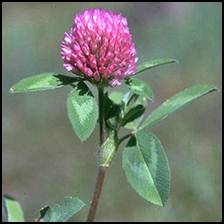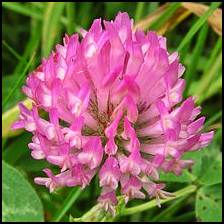You entered Bee Bread, the more common name is...

Red Clover
SCIENTIFIC NAME:(Trifolium pratense)
It is an herbaceous, short-lived perennial plant, variable in size, growing from 20 to 80 cm tall. The leaves are alternate, trifoliate (with three leaflets), each leaflet 15 to 30 mm long and 8 to 15 mm broad, green with a characteristic pale crescent in the outer half of the leaf; the petiole is 1 to 4 cm long, with two basal stipules. The flowers are dark pink with a paler base, 12 to 15 mm long, produced in a dense inflorescence.
Common Names:
Purple Clover, Bee Bread, Trefoil, Clover

Uses:
Red Clover can be used in foods just as Lavender, Marigolds and Dandelions can, and is also used in traditional medicine.Red clover has been used to cure coughs, as an expectorant, to help with asthma, and is used externally for skin problems including irritation caused by insect stings and bites, eczema, psoriasis and wound healing. The flowers are the parts of the herb used, either fresh or dried. Sheep and other animals that graze on these plants develop fertility problems and it is thought that this is because of the phytoestogens they contain. Phytoestrogens are less potent than the oestrogen (the major female hormone) produced in the body, and are contained in the isoflavines (genestein and daidzein) in the plant which are being used in ERT (Estrogen Replacement Therapy) for menopausal women. It has also been found that red clover constituents can help in the prevention of prostate and breast cancer, as well as (perhaps) ovarian cancer, but trials are still ongoing. The flowers contain calcium and magnesium which is easily absorbed by the body and which tones and relaxes the nervous system, minimizing stress and headaches associated with this. The reduction of stress symptoms is also helped by the silic acid content of the flowers.
A syrup can be made to use for the relief of dry coughs. The tea can also be used externally for skin irritation and as a vaginal douche to relieve dryness and the itching which may accompany menopause. It stimulates the functions of the liver and gallbladder, prevents constipation and is an appetite booster. It also supports the uterus, so is a very useful herb for women. Dried or fresh flowers can be added to soups and stews to give them a unique flavor. The fresh flowers are also useful additions to salads.
The dried flowers have been used for bronchitis and asthma and as an expectorant. They are also an alterative, which means that they will produce a gradual beneficial change in the body by improving nutrition, and will act as a blood purifier, getting rid of unwanted toxins. The flowers also have diuretic properties. Like the dandelion and comfrey leaves they are high in protein and calcium.
The fresh flowers can be crushed and applied directly to wounds or stings and bites, and will alleviate the pain and promote rapid healing. They can be used in compresses to relieve the pain of arthritis and gout, and the tea can be used as a coolant for the body.
Red clover contains Vitamin A, iron, chromium, magnesium, phosphorous, potassium, Vitamin C and some of the B-complex vitamins, as well as calcium.
Applications:
Tea:
1 cup of boiling water is poured over 10 to 15 grams of dried red clover flowers or 2 ounces of fresh flowers and allowed to steep for 15 minutes. Strain and drink, 3 cups per day.
Syrup:
Using 2 ounces of fresh flowers and 1 cup of water adding 3 Tbls of honey, boil until the liquid has boiled down to ½ a cup. Take by spoonful when needed for cough.






